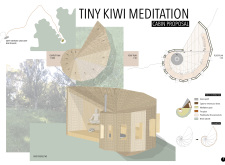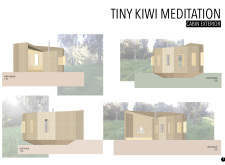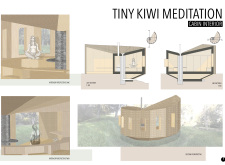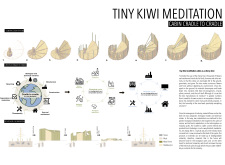5 key facts about this project
The Tiny Kiwi Meditation Cabin is located within the Earth Energies Sanctuary in New Zealand and functions as a space for meditation and introspection. Designed to connect with its natural environment, the cabin provides a tranquil atmosphere for its users. The concept emphasizes sustainability and a deep relationship with the land, focusing on creating a peaceful retreat.
Spatial Distribution
The cabin features a well-planned layout that includes an access porch, a meditation area, and a fireplace. The access porch serves as a transition space, allowing visitors to leave the outside world behind and prepare for a reflective experience. The meditation area is central to the cabin’s design, offering a serene environment supported by the warmth of a fireplace and the option for a small altar for essential oils. Each of these areas is designed to work together, enhancing the overall meditative experience.
Architectural Geometry
Geometric shapes play an important role in the design, creating a balance between structured elements and natural forms. Each facade—North, South, East, and West—is specifically designed to respond to varying light and environmental conditions. This approach optimizes natural light and encourages an interaction with the surrounding landscape. As a result, the design is not only visually appealing but also functional, allowing the cabin to fit comfortably within its setting.
Sustainability Approach
Incorporating a cradle-to-cradle lifecycle philosophy, the design prioritizes sustainability. The materials chosen for the cabin are selected for their potential to be reused or returned to the environment. This reduces the ecological impact of the structure. Furthermore, the project considers biological degradation timelines, reflecting an understanding of how materials can contribute to long-term environmental health.
The Tiny Kiwi Meditation Cabin also draws inspiration from the natural world, specifically the interconnectedness seen in cherry trees. Similar to how these trees provide for various forms of life, the cabin aims to support users while respecting the ecosystem. The varied textures throughout the space invite interaction and reinforce the connection between the occupants and the beautiful landscape that surrounds them.






















































